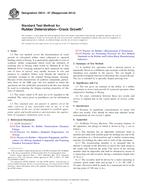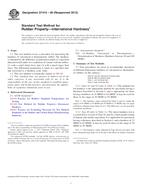We need your consent to use the individual data so that you can see information about your interests, among other things. Click "OK" to give your consent.
ASTM D813-07(2014)
Standard Test Method for Rubber Deterioration—Crack Growth
STANDARD published on 1.5.2014
The information about the standard:
Designation standards: ASTM D813-07(2014)
Note: WITHDRAWN
Publication date standards: 1.5.2014
SKU: NS-39365
The number of pages: 6
Approximate weight : 18 g (0.04 lbs)
Country: American technical standard
Category: Technical standards ASTM
The category - similar standards:
Annotation of standard text ASTM D813-07(2014) :
Keywords:
crack growth, DeMattia (De Mattia) flexing machine, dynamic fatigue, flex fatigue, flexing, flexing fatigue, rubber products, ICS Number Code 83.060 (Rubber)
Additional information
| Significance and Use | ||||||||||
|
4.1 The test gives an estimate of the ability of a rubber vulcanizate to resist crack growth of a pierced specimen when subjected to bending or flexing. 4.2 No exact correlation between these test results and service is implied due to the varied nature of service conditions. |
||||||||||
| 1. Scope | ||||||||||
|
1.1 This test method covers the determination of crack growth of vulcanized rubber when subjected to repeated bending strain or flexing. It is particularly applicable to tests of synthetic rubber compounds which resist the initiation of cracking due to flexing when tested by Method B of Test Methods D430. Cracking initiated in these materials by small cuts or tears in service, may rapidly increase in size and progress to complete failure even though the material is extremely resistant to the original flexing-fatigue cracking. Because of this characteristic of synthetic compounds, particularly those of the SBR type, this test method in which the specimens are first artificially punctured in the flex area should be used in evaluating the fatigue-cracking properties of this class of material. 1.2 The values stated in SI units are to be regarded as the standard. The values given in parentheses are for information only. 1.3 This standard does not purport to address all of the safety concerns, if any, associated with its use. It is the responsibility of the user of this standard to establish appropriate safety and health practices and determine the applicability of regulatory limitations prior to use. |
||||||||||
| 2. Referenced Documents | ||||||||||
|
Similar standards:
Historical
1.5.2012
Historical
1.11.2007
Historical
1.5.2008
Historical
1.7.2008
Historical
1.7.2014
Historical
1.1.2012
We recommend:
Technical standards updating
Do you want to make sure you use only the valid technical standards?
We can offer you a solution which will provide you a monthly overview concerning the updating of standards which you use.
Would you like to know more? Look at this page.



 ASTM D1149-07(2012)..
ASTM D1149-07(2012).. ASTM D1171-99(2007)..
ASTM D1171-99(2007).. ASTM D1229-03(2008)..
ASTM D1229-03(2008).. ASTM D1329-08
ASTM D1329-08 ASTM D1349-14
ASTM D1349-14 ASTM D1415-06(2012)..
ASTM D1415-06(2012)..
 Cookies
Cookies
